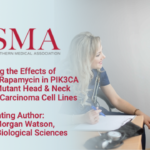Abstract | October 29, 2020
Comparing the Effects of Radiotherapy and Rapamycin in PIK3CA Wild Type and Mutant Head and Neck Squamous Cell Carcinoma Cell Lines
Learning Objectives
- Evaluate the in vitro effect of a single mTOR inhibitor (Rapamycin) on tumor cell proliferation and radiosensitization in HPV(+) and HPV (-) PI3KCA mutant cell lines.
- Evaluate the in vitro effect of a single mTOR inhibitor (Rapamycin) in the mTOR pathway proteins in HPV(+) and HPV (-) WT and PI3KCA mutant cell lines.
Background/Knowledge Gap: Upregulated activity of the PI3K/Akt/mTOR pathway is known to correlate with resistance to radiotherapy in solid tumors. PIK3 pathway alterations are one of the most common alterations in Head and Neck Cancer (HNSCC). The role of PIK3CA genetic alterations in differential radiosensitivity and clinical outcomes of HPV positive and HPV negative HNSCC cases have not been addressed to date. In the present study, we tested the effects of radiotherapy and combination effect of radiotherapy and rapamycin in HPV(+) and HPV(-) PIK3CA wildtype (WT) and PIK3CA mutated HNSCC cell lines.
Methods/Design: Cell survival of HPV positive (+) UMSCC47 and HPV negative (-) negative SCC40 PIK3CA wildtype (WT) and mutant cell lines treated with Rapamycin and/or radiotherapy was determined by clonogenic cell survival assay, while protein expression of PI3K/AKT/mTOR pathway-related proteins was determined by Western blot.
Results/Findings: Rapamycin alone did not reduce significantly the plating efficiency or survival fraction of HPV (+) and HPV (-) PI3KCA WT and mutant HNSCC cell lines. The addition of increasing doses of radiation to Rapamycin pre-treated samples decreased the proliferation capacity of the HPV (+) and HPV(-) PIK3CA WT and mutant cell lines and further reduced the survival fraction. Rapamycin pre-treatment showed an additive effect in sensitizing HNSCC HPV (-) SCC40 WT cells to radiation (p=0.045), however this effect was not observed in HPV (+) SCC47 PIK3CA WT and H1047R mutant cell lines (p=0.811 and p=0.238, respectively), nor HPV (-) SCC40 PIK3CA mutant H1047R and E545K (p=0.208 and p=0.399, respectively). Also, we found that there was increased phosphorylation of AKT and decreased phosphorylation of pS6 when HPV (+) SCC47 PIK3CA mutant H1047R and E545K cell lines were treated with Rapamycin in conjunction with radiation. In contrast, we found increased phosphorylation of S6 and AKT when HPV (-) SCC40 PIK3CA mutant H1047R were treated with Rapamycin in conjunction with radiation.
Conclusion/Implications: We observed that in vitro, regardless of HPV status, a single mTOR inhibitor (Rapamycin), does not radiosensitize PI3KCA mutant cell lines. In our study, we found higher expression levels of PI3K/AKT/mTOR-related proteins in HPV (-) PI3KCA mutant E545K HNSCC cell line compared with HPV (+) PI3KCA mutant E545K HNSCC (E545K), suggesting that the PI3K/AKT/mTOR signaling pathway might contribute to HPV (-) PI3KCA mutant HNSCC radioresistance.

